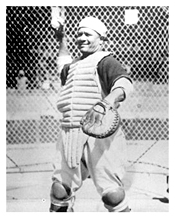

Larry Brown
Nickname: Iron Man
Career: 1919-1949
Positions: c, manager
Teams: Birmingham Black Barons, (1919), Indianapolis ABCs (1921-1923), Pittsburgh Keystones (1922), Memphis Red Sox (1923-1925, 1927-1929, 1931, 1938-1948), Detroit Stars (1926), Chicago American Giants (1927, 1929, 1940), New York Lincoln Giants (1930), Harlem Stars (1931), New York Black Yankees (1932), Cole's American Giants (1932-1935), Philadelphia Stars (1936-1938)
Bats: Both
Throws: Right
Height: 5' 8'' Weight: 180
Born: September 5, 1905, Pratt City, Alabama
Died: April 7, 1972, Memphis, Tennessee
An outstanding receiver with a quick release and an arm to be envied, Larry Brown was a master behind the plate. In the field, whether smothering dirt balls or handling pop flies, he was tops but was noted for the peculiar practice of not removing his catcher's mask on pop-ups. A conscientious, hard worker popular with the fans but rough on umpires, he was a durable workman credited with catching 234 games in 1930 for the New York Lincoln Giants, earning the nickname "Iron Man." In addition to his superior defensive skills, the husky catcher was a smart ballplayer who became a successful playing manager during the 1940s with the Memphis Red Sox. He played on three championship teams and in six All Star games, which are indicative of his value to a team.
His first championship came after he and Nat Rogers joined the Chicago American Giants late in the 1927 season from Memphis. He was the starting catcher in the Negro World Series rematch against the Eastern Colored League's Bacharach Giants, a team that had stolen 19 bases in the previous Series without Larry behind the plate. In the 1927 Series he neutralized their running game as he gunned down four of the eight attempted base stealers. After the World Series was over, he and Rogers were ruled by Negro National League president Hueston to be the property of the Memphis Red Sox.
Six years later, Brown returned to the American Giants to provide stability behind the plat, as they won the Negro National League championship in 1933 and came within a game repeating in 1934, losing a hard fought, seven game playoff to the Philadelphia Stars. Thetwo seasons also marked the first two East West All Star games, and he was selected to start the All Star game for the West squad each of these years.
In the spring of 1938 he rejoined the Memphis Red Sox and help them annex the first half Negro American League title. That year also marked the first of a string of four more consecutive All Star appearances (1938-1941) and, although he was not noted for his hitting, he had a .308 average to show for his six All Star games. Generally he maintained respectable batting averages, with marks of .292 and .289 in 1928 29. Partial statistics show identical .431 averages for two years with Cole's American Giants, 1932 and 1934, but more characteristic of his batting skills are averages from some of the better teams he played with during his career, including .253 (1927 American Giants), .256 (1930 Lincoln Giants), and .262 (American Giants). He is credited with a .259 lifetime average for his 31 seasons in black baseball.
Although he is most closely identified with the Memphis Red Sox, Brown played with ten different teams during his career. He was a heavy drinker, which possibly also contributed to his frequency of uniform changes. He was best known for his defensive skills, and his cannonhike arm generated a story that, although unsubstantiated persists.
Oral tradition insists that while playing against Ty Cobb in Cuba in the winter of 1926, Brown threw out the legendary base stealer on five consecutive attempts to steal second base. According to the story, Cobb was sufficiently impressed to try to get the light-skinned Brown to pass as a Cuban and play in the major leagues. The story has not been conclusively proven or disproven. Similar stories insist that Rogers Hornsby wanted to pass him off as a Cuban, but Brown objected to the plan.
Source: James A. Riley, The Biographical Encyclopedia of the Negro Baseball Leagues, New York: Carroll & Graf Publishers, Inc., 1994.

Larry
"Iron Man" Brown